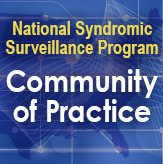Alabama Department of Public Health–Syndromic Surveillance: Monitoring and Improving Data Quality
Healthcare Use

The Alabama Department of Public Health (ADPH) uses syndromic surveillance to recognize and respond quickly to public health threats. Healthcare facilities are expected to submit 95% of syndromic data within 24 hours of a visit. When facilities are slow to process and submit data, the usefulness of data is diminished.
To better monitor data and resolve data latency, ADPH reviewed data timeliness and data quality reports provided by the National Syndromic Surveillance Program (NSSP). For facilities setting up new data feeds, the analysts used these reports to identify needed data improvements. For the 82 facilities with established data feeds, they monitored missing or late transmissions and any backlogs. They also tracked the reasons for data not being current (e.g., suspended production due to software change or upgrade) and dates when data issues would be resolved. Now they have an accurate status for participating facilities on any given day.
Armed with good data, ADPH analysts developed a better understanding of the nature, behavior, and limitations of each facility and were better prepared to engage facility staff to resolve problems. Funding from the National Syndromic Surveillance Program supports the use of syndromic surveillance in improving the nation’s public health.
Public Health Problem
Data latency limited the Alabama Department of Public Health’s (ADPH) ability to recognize and respond quickly to public health threats. Despite ADPH’s request that 95% of syndromic surveillance (SyS) data be submitted to ESSENCE* within 24 hours of a visit, some facilities were slow to process and submit data, diminishing the data’s usefulness for surveillance that, in turn, negated ESSENCE’s ability to function as a daily alert. Data could be one to several days late, depending on whether a facility was processing or sending data or was offline.
Actions Taken
ADPH’s SyS analysts used a multifaceted approach to better monitor data and resolve data latency in ESSENCE. They improved quality, timeliness, and utility by using a combined analysis of the NSSP reports downloaded from the WinSCP application, R-programing, and Excel tracking. This helped them identify where improvements were needed before an onboarding facility could transition to production. They also used these reports to improve data when, for example, they noticed a production facility had stopped sending data to ESSENCE, an anomaly had occurred requiring investigation, or a production facility had to be re-onboarded. Once the analysts observed high-quality data flowing into ESSENCE, they shifted their focus to timeliness of data from the 82 facilities in production. Sometimes a facility would send data late or circumstances could cause a backlog exceeding 3 days. Such occurrences prompted the SyS analysts to develop a “Current Production Status” spreadsheet where they could record the status of each facility when data were not current (for example, when a facility suspended production due to a vendor change or upgrade). The spreadsheet lists all facilities in production at any given time and the feed status. SyS analysts began using RStudio Pro to query changes in data status before data reached ESSENCE. The query returned the names of facilities where slowdowns were observed.
Outcome
The SyS team used the data quality reports to transition seven facilities from onboarding into production and to initiate discussions with facilities about how reporting could be improved. For example, some facilities can only send data once every 24 hours—causing a lag time to ESSENCE of almost 48 hours. The SyS team learned that these facilities might not be able to improve their timeliness measure without incurring vendor costs for an upgrade. Also, the SyS team created a Current Production Status spreadsheet to provide users an accurate status of facilities in the catchment area on any given day. The team is integrating this spreadsheet into an Access database to function as a dashboard for registered ADPH staff who use ESSENCE. The dashboard will allow access to each facility’s current data quality reports and give ESSENCE users a window of confidence into data before they run reports.
*Electronic Surveillance System for the Early Notification of Community-based Epidemics
Lessons Learned
- Analysts should use data quality reports to engage facilities. Some barriers that affect facilities might not be obvious (for example, having insufficient funds to upgrade to a system that is timely).
- The absence of data in ESSENCE does not necessarily mean that the facility is not sending data.
- Analysts need to understand the nature, behavior, and limitations of the facility to improve reliability of data feeds, improve data quality, and reduce data latency.
Contacts
Infectious Diseases and Outbreaks Division
Bureau of Communicable Disease
Alabama Department of Public Health
MisChele.Vickers@adph.state.al.us
Office of Public Health Data, Surveillance, and Technology
Division of Health Informatics and Surveillance
www.cdc.gov/nssp
This success story shows how NSSP
- Improves Data Representativeness
- Improves Data Quality, Timeliness, and Use
- Strengthens Syndromic Surveillance Practice
- Informs Public Health Action or Response
The findings and outcomes described in this syndromic success story are those of the authors and do not necessarily represent the official position of the National Syndromic Surveillance Program or the Centers for Disease Control and Prevention.
